The simple and reliable Bell & Howell 625C Projector
Bell & Howell was a very big company in the field of home movie making in the ’50s and ’60s with many different models of camera and projector available to cover most people’s pockets. The projector covered in this article, the Bell & Howell 625C 8 mm projector, was one of a number of different models made with a similar upright design, which Bell & Howell produced throughout that period. The range started with simple manual feed, standard 8 machines and graduated to auto-feed and dual standard machines which could also project super 8 film.
The Bell & Howell 625C featured here is one of the earliest models in the range and is also one of the simplest in design.
Pictures of the Bell & Howell 625C Projector
The gallery below shows some images of the projector.

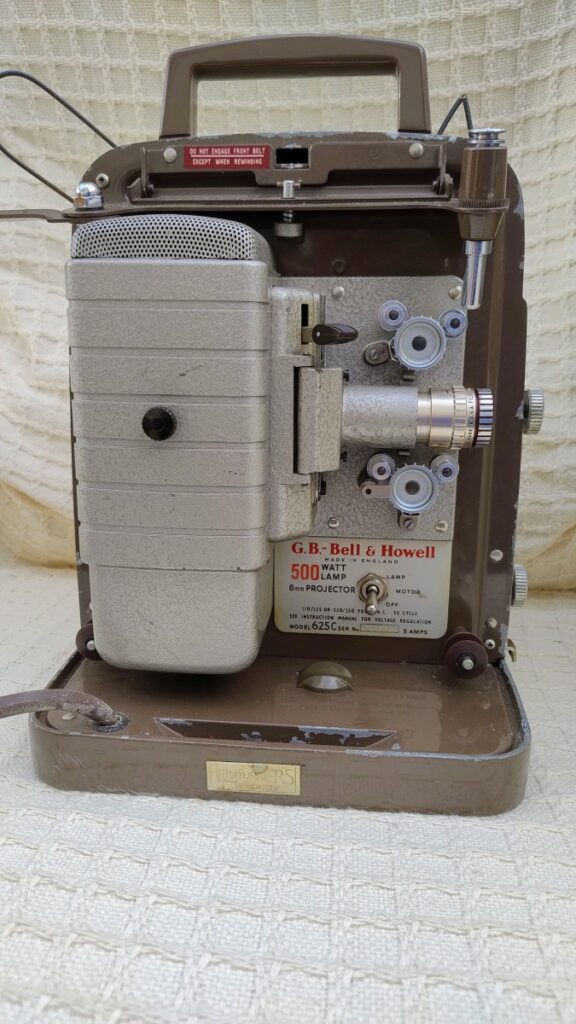


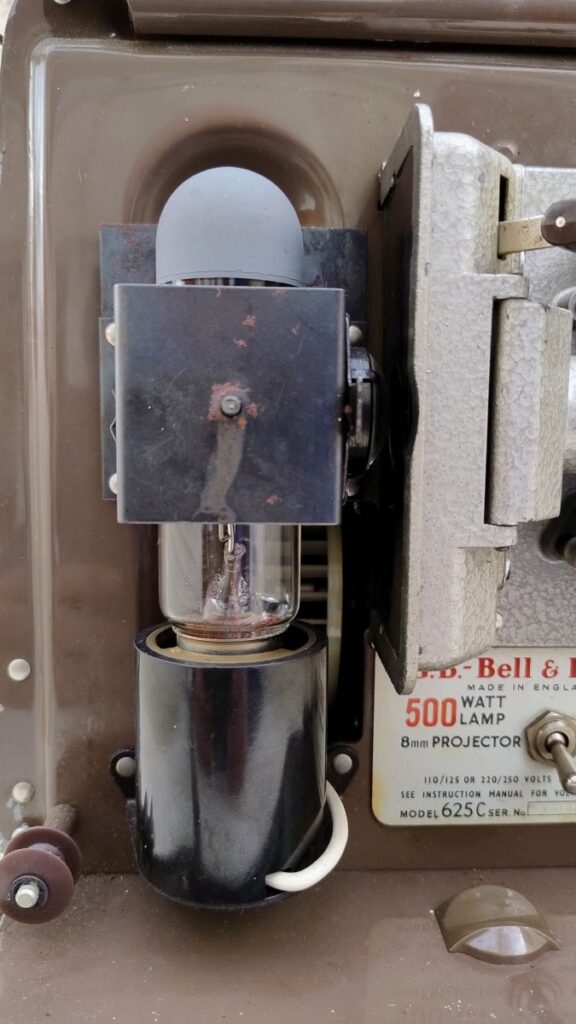
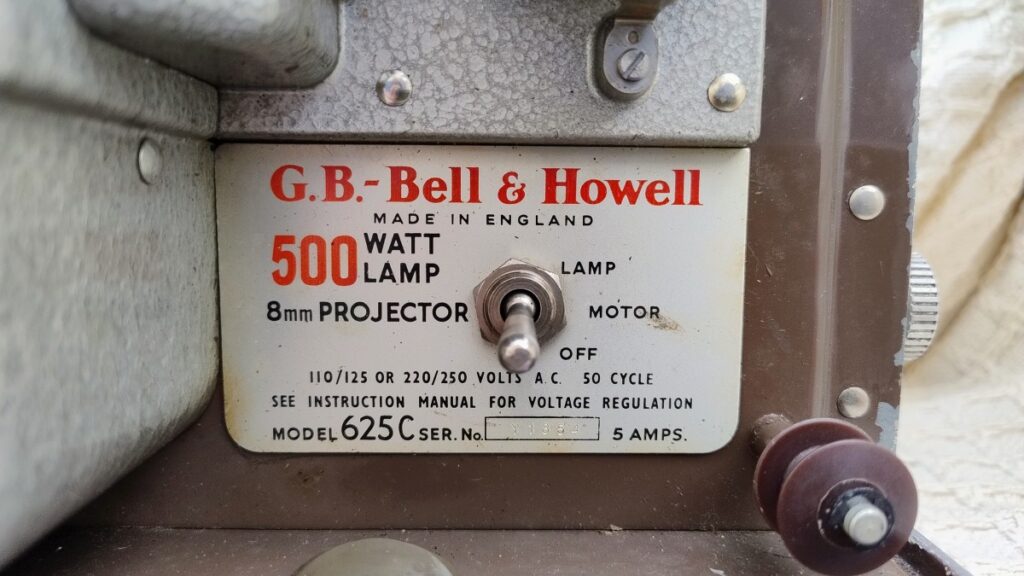
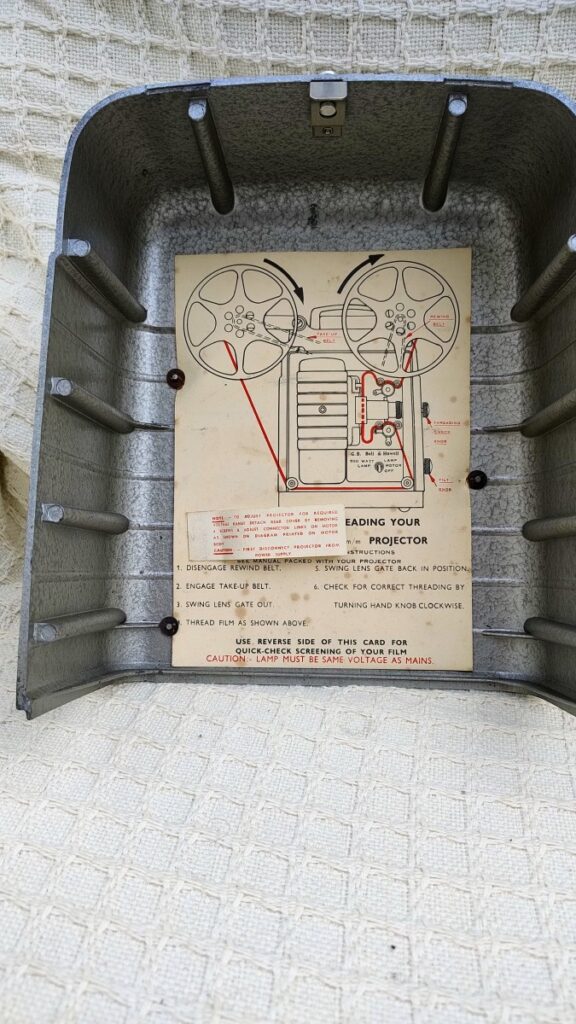
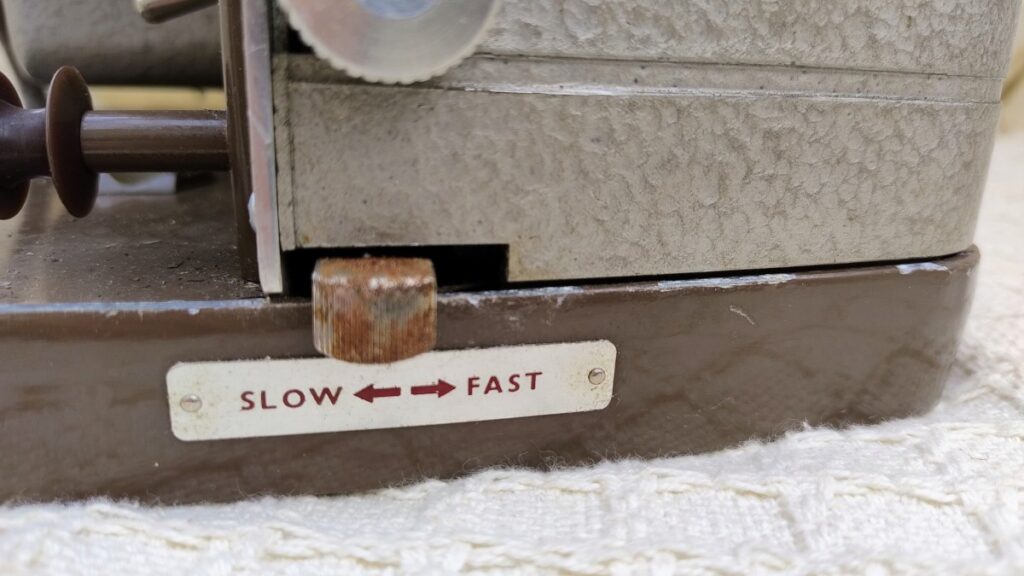


My Bell & Howell 625C Projector.
I actually own two examples of this model of projector and the photos in the article come from both models. I happen to have two copies because someone donated a model to Everything Vintage and after I found that it wasn’t working I was intrigued enough to purchase another model to try to construct one working model from the two.
In fact it’s not completely accurate to say that the unit which was donated to Everything Vintage wasn’t working because I’m sure it was working when it was donated, but when I eventually fitted a plug and tried it with power, the lamp flashed and then died1.
I was pretty upset about that, because the lamp is the most expensive part of a vintage projector and wouldn’t be easy to replace, which is why I purchased another unit (which was shown in the eBay listing with the lamp running). It’s a perverse fact that while it’s prohibitively expensive to buy a lamp, if you buy a projector with the lamp in, it’s quite cheap.
The donated projector was supplied in pretty good condition. The only missing item I know of is the take-up reel which should be fitted in a shallow dip in the case and normally has the power cable wrapped round it. It’s not unusual for this to be missing – if you search for this model projector on eBay, most units don’t have it.
There was also no mains plug fitted to the unit, but that was a simple issue to rectify and once I’d done that and plugged the unit in, the motor worked, but as I said above when I switched the power to the lamp there was a flash and the lamp blew.
As it blew, the motor also stopped, which made me wonder if the power to the motor is supplied through the lamp – it’s possible that the lamp was used as a voltage dropper in which case the blown filament would have removed power from the motor. However, after a bit of investigation it turned out that the shorted lamp had blown the fuse in the plug!
My second example of the projector was purchased from eBay for the sum of £15 and was in remarkably similar condition to the donated unit. Again the take-up reel was missing, but other than that everything else was in order.
When I tried running the second unit, it runs and the lamp lights although the main drive belt has expanded slightly over the years so the projector will only run on the fastest speed.
Bell & Howell 625C Description
I would estimate by the general design of the Bell & Howell 625C projector, that it was first introduced in the early 1950s.
The unit is of a straight forward and reliable design as evidenced by the fact that both the units I have run2 after probably 70 odd years.
The unit is rectangular in design with the shortest sides being the top and bottom. The front case is removed by pressing a small button at the top which allows it to be pulled away. The back case is held in place with four screws which need to be removed to release it, although I found that the case was impossible to fully remove because the spring drive belts are looped through holes in the case.
To use the projector the film is fitted to the front film holder and the take up spool fitted to the back film holder once the film transport arms are extended.
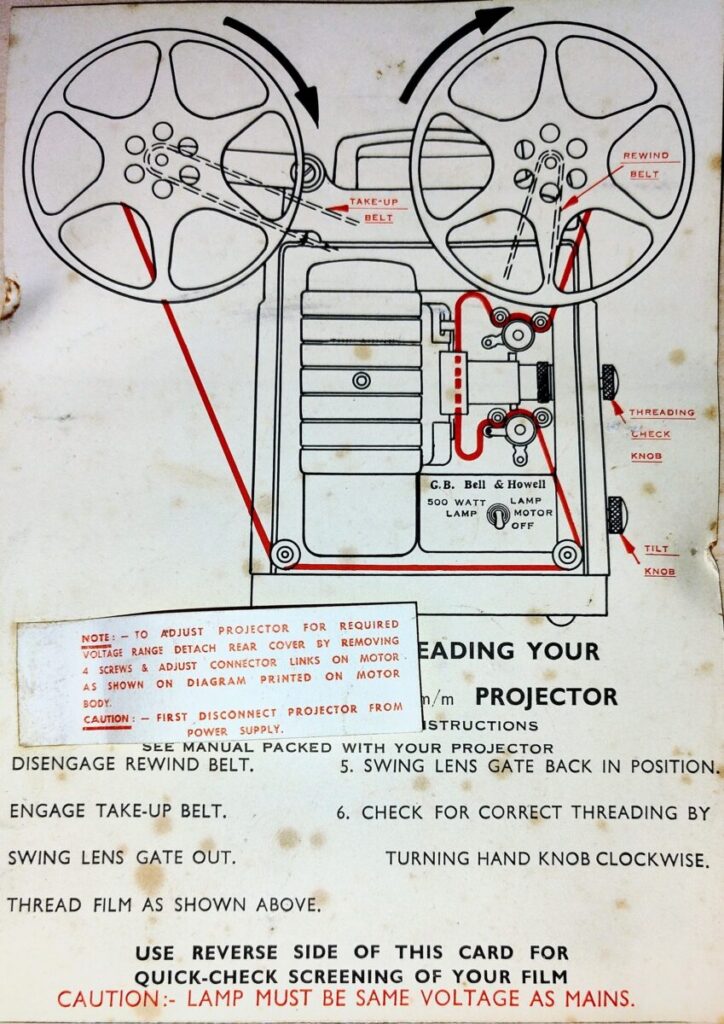
The film transport arms are fitted to a folding bracket mechanism at the top of the unit, with the spring drive belts emerging from the back of the projector to fit around drive pulleys on the back of the spool holders.
When the projector is cased, the film transport is folded down and sits within the cover, but when the case is removed the bracket fold up and is held in place with a ‘push and turn’ button to lock it in place.
For normal projection only the rear drive belt is fitted and for rewind only the front drive belt is used.
The film is threaded from the feed reel to the take up reel using the quite complex path shown in the image to the left.
Although the lens unit un-clips to make it easy to fit the film through the film gate, I couldn’t find a simple way to move the sprocket wheel out of the film path and I assumed it would be difficult to thread the film. In fact, this was one of the easiest projectors in my collection to thread with film. As long as there is enough leader on the film so that the full length required from feed reel to take-up reel is available, the film just pushes into place very easily.
The controls are very simple to operate because there are no fancy frills to the Bell & Howell 625C. There is a simple switch which turns on the motor and then another position to turn on the lamp. To focus the image you turn the lens in it’s holder, and to frame the image3 there is a small leaver above the film gate.
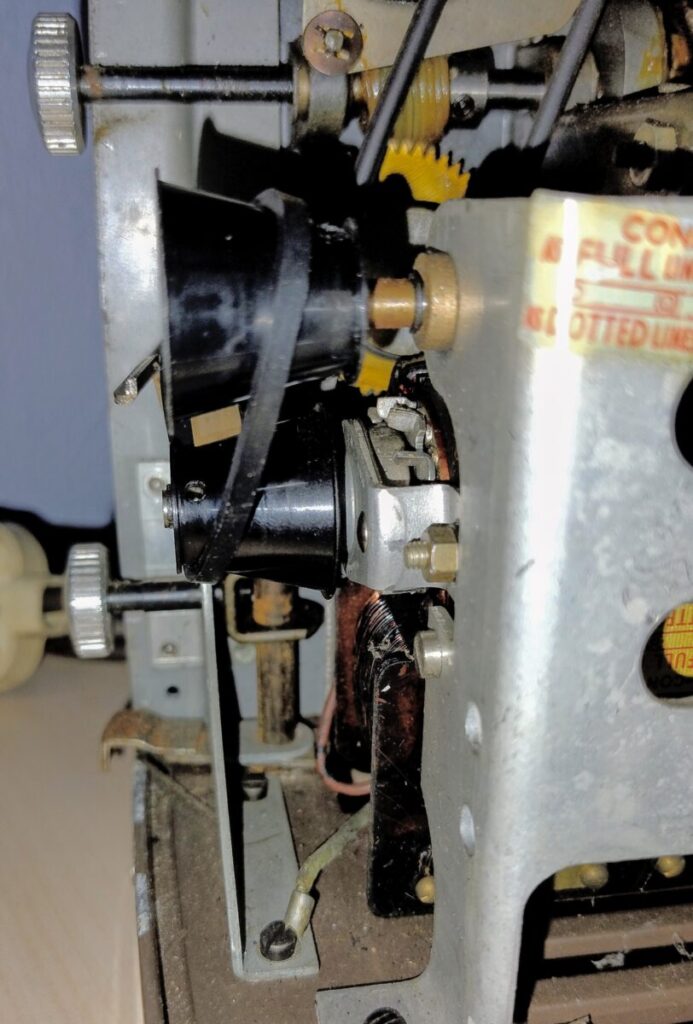
The projector has a speed control which adjusts the frame rate the projector is running at which was a fairly standard option on 8 mm projectors, but the mechanism on this unit is quite clever.
Often a rheostat would be used to adjust the current through the drive motor to adjust the speed which, although it works, wastes power and can cause reliability issues because the rheostat can get hot.
This projector leaves the motor running at a constant speed and instead has two conical shafts with a drive belt connecting them. This is shown in the image to the right.
The conical shafts are connected to the motor and the projector drive system and there is a mechanical leaver which moves the position of the drive belt either to the back, where motor drive shaft is at it’s maximum diameter, or to the front where it’s at its minimum diameter.
Because the conical shapes are the same but reversed on each shaft, the distance between any point on the shaft is the same, but as the drive belt moves the ratio of the two shafts change and therefore the speed transmitted changes.
Once the projected film is finished the film is rewound to the original spool by connecting the film directly from the take-up spool to the feed spool and swapping the sprung drive belt so that the front belt connects to the front spool pulley. When the motor is switched on the film is wound back on the original spool.
Bell & Howell 625C Projector Specs
- Standard 8 projector made in the early ’50s.
- 500 Watt lamp gives a bright image.
- Portable unit with everything contained in a single case.
- Simple threading.
- Adjustable foot to set projection angle.
- 15 mm to 20 mm zoom lens fitted to one model, simple fixed focal length fitted to other
- Mechanically simple meaning less things to go wrong
Pros and Cons of the Bell & Howell 625C Projector
This is my assessment of the projector from the standpoint of a collector of both projectors and vintage home movies so I rate it from the point of view of purchasing a projector to view old family films.
Pros
The unit is simple in operation and therefore has fewer failure points. Basically you can assume you would need to replace the drive belts but the rest of the mechanics seem quite reliable and sound.
The unit is simple to thread and seems to run reliably and quite quietly. I haven’t tried projecting a very large image, but the 20 inch image I did project was quite bright.
It’s easy to remove the film mid projection and rewind it if you want to. More modern projectors which have auto-feed make it almost impossible to do this, but sometimes you don’t want to watch the whole film so it’s nice to be able to stop.
There is a definite feeling that this style of projector ‘fits the bill’ when showing old films. You certainly feel as if you are using equipment that matches the age of the film in a way that I think you wouldn’t if you used an automated projector from the ’80s or ’90s.
Cons
The most obvious negative point is the cost of a replacement lamp when you need to replace it. The lamp is no longer made, so the only way to replace one is with a ‘new’ old stock lamp, or by purchasing another projector with a working lamp in. At current prices a replacement lamp is about £30 and a replacement machine is probably about £20 once postage is added.
Because the lamp is 500 Watts, the projector will be more expensive to run than a more modern unit with a lower wattage lamp. Although the cost won’t be huge, with today’s inflated energy prices it’s a consideration.
- It’s probable that the lamp filament was damaged during its trip to me via the postal service [↩]
- other than a blown lamp which was always the most unreliable element of the projector – I remember my father saying that he always left the projector to cool down after a session because the lamp was most fragile at that point but even when the projector was first made the lamps only had a life of a few dozen hours [↩]
- make sure the full picture sits in the middle of the projected image [↩]
Discover more from Everything Vintage
Subscribe to get the latest posts sent to your email.

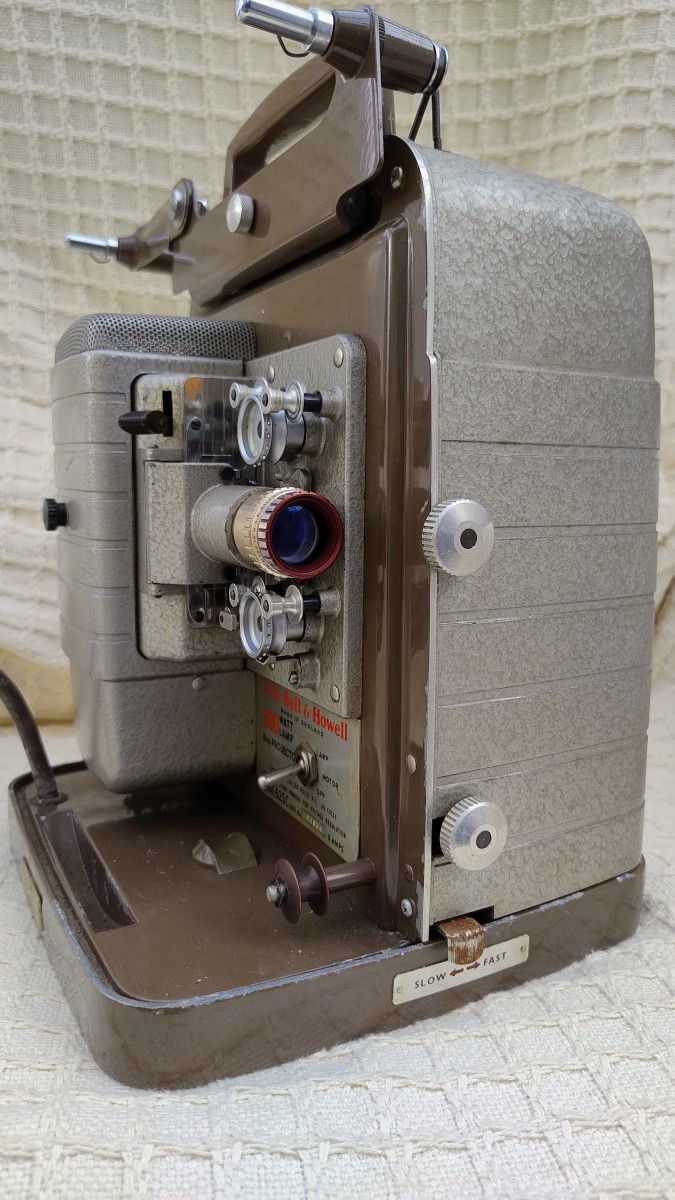
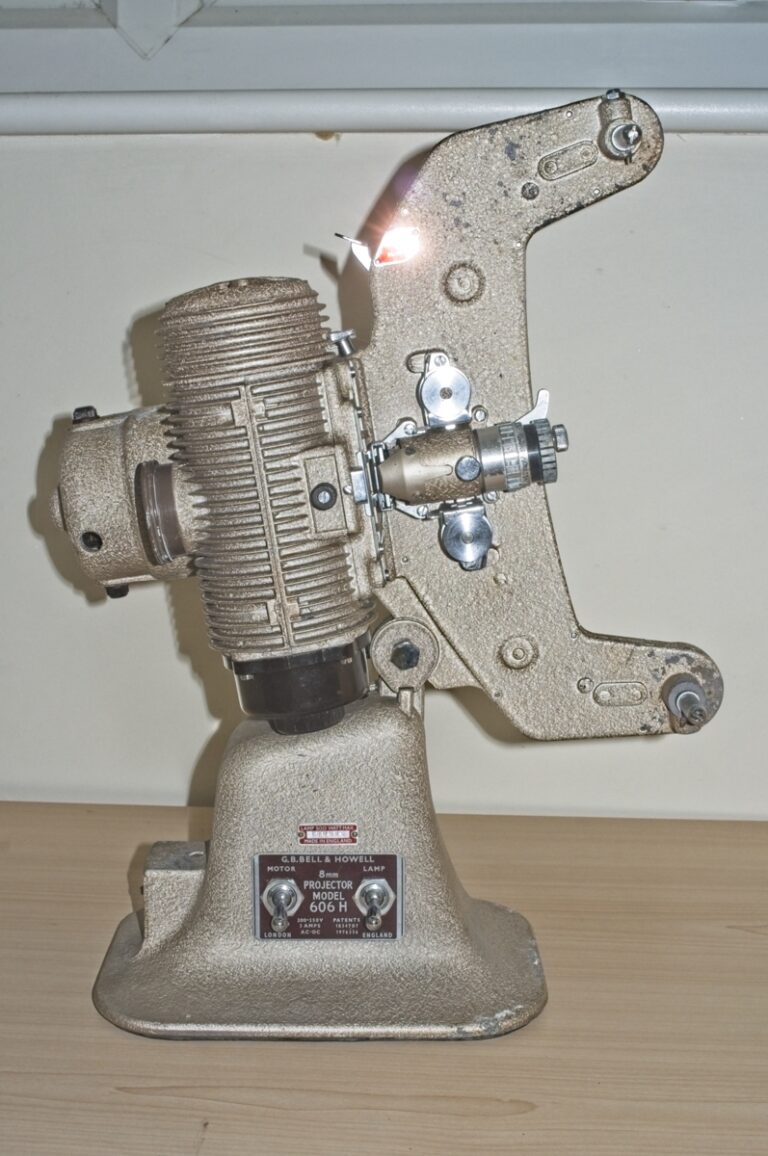
Helpful, informative, detailed article.